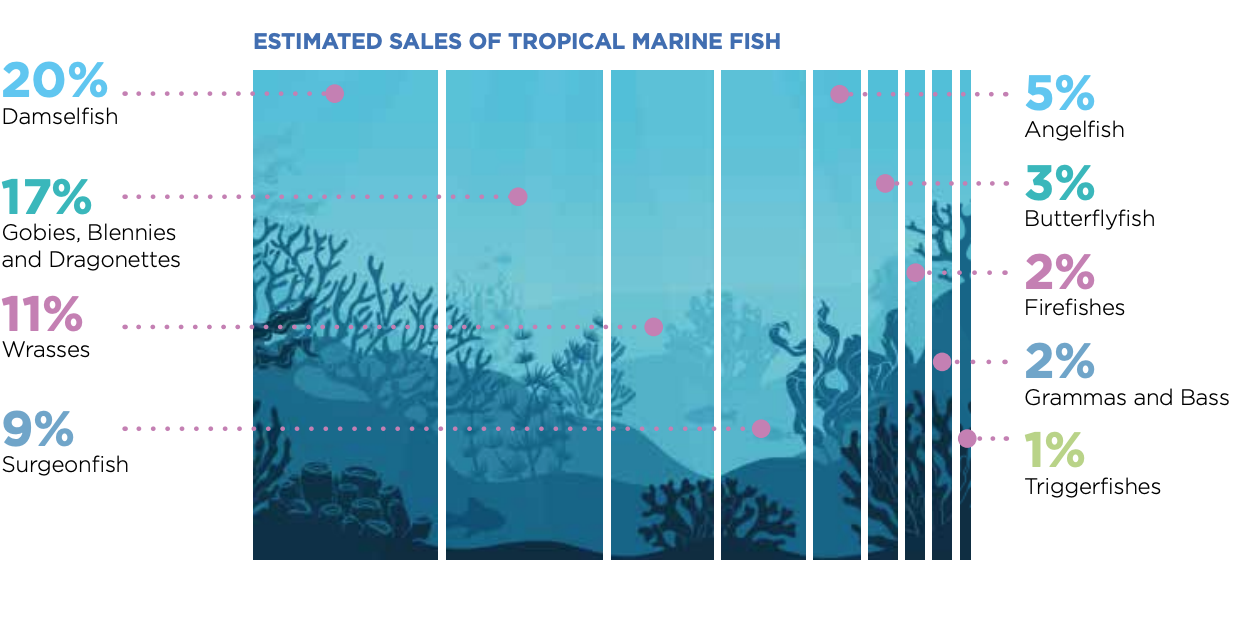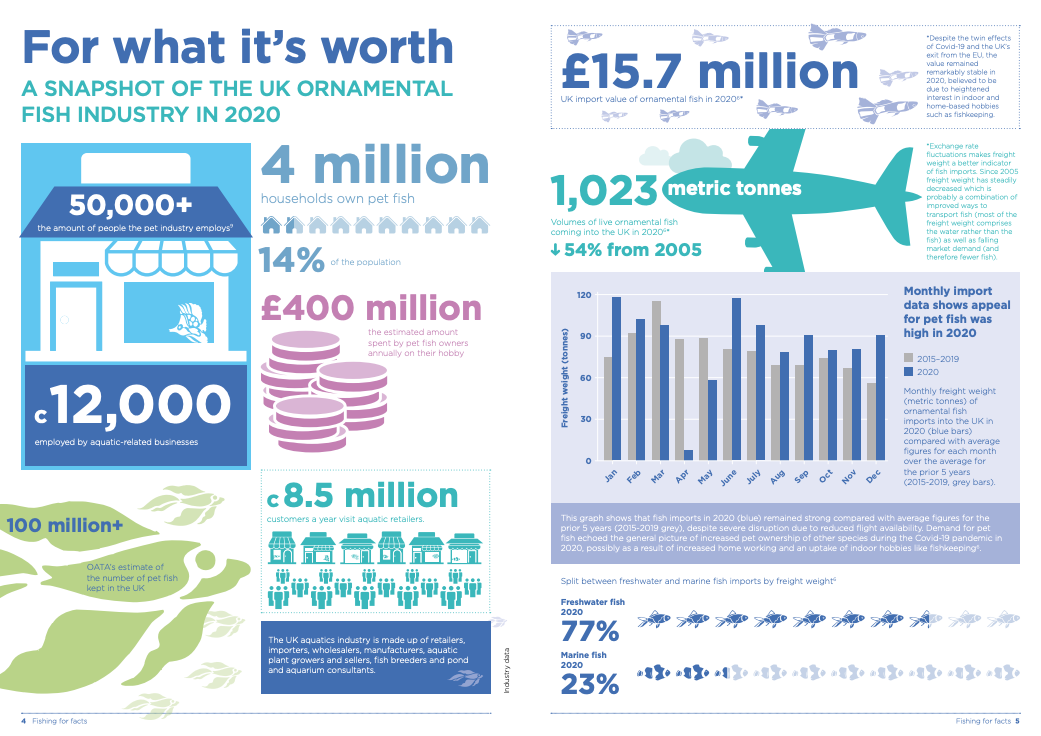All reefkeepers have a wobble now and again and wonder about the impact their hobby has on the environment. But the UK’s Ornamental Aquatic Trade Association has painstakingly assembled fact-based data that’s going to make everyone selling fish and keeping fish feel a whole lot better.
Fishing for Facts is their latest publication examining the trade in fish for home aquariums and garden ponds in a bid to tackle misconceptions about the industry. Its UK-centric as is their remit, but it’s absolutely filled with stats on the global fishkeeping industry that we should all read and take notice of. It’ll better arm us against industry haters too.
Numbers, numbers, numbers!
The report starts by splitting ornamental fish into freshwater and marine, but then further dissects the marine sector into families and species. “There are estimated to be fewer than 700 marine ornamental fish species in trade in the UK and the majority of these are sold in small quantities.” It says. “Fewer than an estimated 120 species make up 80% of the UK marine ornamental fish trade.”
Damselfish top marine fish sales with 20% of the market, although Clownfish are in Pomacentridae too, so that makes sense. Next are gobies and blennies at 17%, wrasses at 11%, surgeonfish at 9% and angelfish at 5%.

Freight weight
In 2020 the UK imported 1023 metric tonnes of live ornamental fish with a total value of £15.7 million, 23% (235 tonnes,) of which was marine fish. This was calculated by freight weight of imports though, which also includes the water the fish travel in. Although it showed that it was less than half the weight of fish imported in 2005, perhaps showing more efficient fish packing methods but also market decline.
But that’s put into stark contrast with the 80.9 million tonnes (340,000 times as many!) marine fish that are caught as food every year.
Lower mortality
“Fish mortalities in transport are lower than generally thought,” says OATA. “Fish mortalities are often seen as a barometer of bad practice and there is a much-cited statistic of 73% mortalities in the global ornamental fish trade. This figure is erroneous at best as it refers to a study published more than two decades ago. It has been disputed by recent research, particularly given that it refers to sparse, anecdotal evidence from a specific group of importers rather than from verified data.”
“Neither does the figure withstand economic scrutiny as no industry could sustain itself over the long term if such losses really existed. The Heathrow Animal Reception Centre, where 80% of ornamental fish pass through its inspection processes, have noted less than 1% of mortalities on arrival. It has also been acknowledged by the CITES Animals Committee that high mortality amongst shipments of live animals is mostly an issue associated with illegal trafficking.”

Over collection of wild fish
Where fish are collected from the wild, the report says efforts are made to ensure they are sourced sustainably and there is no over-exploitation, for example by the seasonal rotation of collection sites. The most common species in trade, Chromis viridis, is abundant in the Indian and Pacific oceans (from east Africa to Hawai’i) and collected from dozens of collection points in order to avoid overexploitation in any one region.
“The trade in ornamental marine organisms is considered low volume, high value,” it goes on. “Ornamental fisheries in general target small-bodied individuals, as the market is for younger, small-bodied fish over large fecund adults that support overall population productivity. For instance, the full adult body size of the Common Clownfish is around 10cm but individuals are commonly sold at 2-3cm.”
“As such, the relative impact on the overall fish stocks of targeted species is low. Targeting small to medium-sized individuals has long been a suggested strategy for reducing the impact of commercial food fisheries. Recent work on the export of ornamental marine fish from Indonesia found that approximately 85% of the species sold were listed as Least Concern on the IUCN red list. In addition, recruitment of fish to coral reefs (where most ornamental species in trade are found) is often said to be space limited, not resource-limited.”
“Coral reefs are highly productive, and the removal of select individuals is likely to free up space for new individuals to settle there, maintaining high levels of fish biomass. The methods of fishing for ornamental marine species has often been scrutinised due to the prevalence of local fishers employing destructive and illegal fishing techniques such as cyanide poisoning and blast fishing.”
“Such practices are not supported by the UK trade in marine ornamental fishes, with industry working with local fishers to discourage their use in favour of low impact, collected-to-order fisheries. Because of this, a general decline in such practices has been observed in ornamental fisheries, with local fishers favouring low impact hand netting techniques.”
“Businesses that supply marine ornamentals regularly audit their supply chains to ensure that the animals are healthy and not the product of destructive fishing techniques. Ultimately, the trade and hobbyists alike are dependent upon the provision of live, healthy fish, and there is no market for fish collected using cyanide fishing or other destructive techniques.”

Cyanide testing
The industry plays its part in seeking to tackle illegal cyanide fishing too. OATA and Sea Life Aquariums commissioned the Centre for Environment, Fisheries and Aquaculture Science (CEFAS) to produce two independent scientific reports examining the current challenges associated with the detection and prevention of cyanide fishing and how these could best be overcome to implement a robust and practical cyanide detection method.
The suitability of current tests was also reviewed in a bid to come up with recommendations on ways forward to halt this illegal practice. Businesses in the aquatics industry have been active in working to develop the technologies required for a test that can detect whether ornamental fish were collected using cyanide.
The report has been sent to more than 130 politicians across the UK as well as more than 200 relevant government officials across all the administrations and related organisations. If you crave more industry stats (and there’s way more,) check out another OATA report, “Wild Caught Ornamental fish – The trade, the benefits, the facts,” also available from OATA’s website.
Read it and you’ll feel a whole lot better about the industry your hobby supports.



